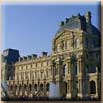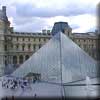 ouvre
ouvre
 ouvre
ouvre
 |
 |
 |
Rebuilt in the mid-16th century for use as a royal palace, the Louvre became
as the residence of the King. In 1527,
Francois I announced is intention to take up residence in the Louvre. He was
the first eminent patron of Renaissance Italian masters. Twelve paintings from
his original collection, including the Vinci's Mona Lisa, Raphael's Belle Jardiniere
and Titian's Portrait of Francois I are among the most important masterpieces
of the museum. Buildings were added and remodeled to remain a royal residence
until Louis XIV in 1682 when the King relocated the Court to Versailles. The
palace was neglected for nearly 100 years. Louis XV, in order to transform the
monument in a royal collection, began to restore the palace. The Louvre began
its career as a royal museum accessible to the public on 10 August 1793, when
the doors of the Grande Galerie were opened to the visitors. Napoleon built
the north wing of the palace and used the edifice for storage and display the
spoils of empire. Many of the works of art exacted as a tribute from countries
he conquered were reclaimed in 1815. He commissioned the Carrousel Triomphal
Arch. Refurbished throughout its history, Le Louvre was completed under Napoleon
III. Louis XVIII, Charles X, Louis-Philippe all further endowed the collections.
The courtyard was bounded by the Tuileries, burnt down under the Paris Commune
in 1871. Le Louvre, today. Gifts, legacies and acquisitions continue to enrich
the collections every year. In 1988, the president Francois Mitterrand decided
to devote the entire palace to the museum and asked to I.M. Pei to add a glass
pyramid to the palace courtyard. Over the past decade, the French government
has invested over US$ 1 billion in restoring, renovating and upgrading its exhibition
halls and public spaces. Today, the museum is the world's largest museum.
|
||||||
|
||||||
| Metropolitan Museum | d'Orsay | Russian State Museum | ||||
| Facts | ||||||